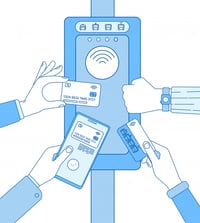Printed Antennas are a common form of Printed Electronics used to enable wireless communication. Printed Antennas for wireless communications are more common than you might expect, and this will only increase in the future.
Printed Antennas for Wireless Communications
As stated in the introduction, printed antennas are increasingly (prod)used. Companies that use such antennas for wireless communications very successfully, are sports retailers. However, the antennas used are made by etching, instead of printing. These antennas are used for the checkout of products, but also inventory. It eliminates a lot of labor-intensive work, it is easier to take stock and the error margins are minimal. It is expected that more and more companies with large inventories will implement this as well.

There are various technologies for such wireless communications, but by far the most common are NFC and RFID. Together they account for up to 98% of all printed antennas for wireless communications. We will briefly discuss these common technologies below:
1. NFC-tags
NFC stands for Near Field Communication. This is a wireless communications method for extremely short distances. The range for data exchange is limited to just 10 centimeters. If you compare this with Bluetooth, for example, fewer data will be lost with NFC as NFC-tags do not easily interfere with each other. Also, less time is needed to connect, which is a major benefit for scanning access cards or your ATM card.
An NFC tag consists of an antenna and a chip. The tag itself does not use any power and is "passive"; The energy it needs to exchange information is generated by the antenna. This makes NFC tags an extremely cheap form of wireless communications.
NFC is used for various purposes. For example, the readers are incorporated into smartphones to carry out payment transactions. Access and loyalty cards also contain NFC tags to be scanned quickly. The fact that NFC tags only work up to 10cm is a big advantage for the applications they are used for. After all, you don't want your ATM card to be read by a device that’s 8 meters away. Some applications need more distance.
2. RFID-tags
Applications that do require scanning at longer distances include RFID (Radio Frequency Identification). These tags can be scanned up to 8 meters.
The two most important RFID types are High Frequency and Ultra High Frequency. For HF, the distance required is small, which brings the technology closer to NFC. The antenna that has to be printed for this is not very different. Ultra HF is used for longer distances, such as tracking goods and suitcases at airports and items in shops. Library books also often contain RFID technology.
Depending on the type of RFID, it works at greater distances and does not require a direct line of sight as is the case with NFC tags. In addition, RFID-readers can read hundreds of tags simultaneously, which is not possible with NFC tags. Although RFID has many advantages, this wireless communications technology is much more sensitive to privacy violations and fraud. Also, codes from RFID chips can interfere with each other or with remote medical equipment.
Another disadvantage of RFID chips is that they are often used on one-off applications that are then thrown away. These disposables make the technology very environmentally unfriendly. This also applies to its production: 95% of RFID chips and NFC tags are produced by etching. This creates a lot of residual waste. For this reason, countries such as China are now imposing restrictions on etching. Other production technologies are required.
Rotary Screen Printing for Printed Antennas
This environmental issue can easily be circumvented by printing directly on materials. For this reason, more and more companies print directly on the substrate through rotary screen printing instead of etching. Of course, each material is different. Film, for example, is not degradable, but paper is recyclable.

Rotary screen printing is a rotary printing process that is ideally suited to Printed Electronics and printed antennas. Due to the roll to roll process in combination with rotary screen it is very suitable for high volume print jobs. Because of this, you can reprint the same printed antenna countless times. This works for both NFC and RFID applications. Important additions for the environment: no etching is required, less residual waste is left over and other substrates like paper can be used.
Printing printed antennas for wireless communications is very easy with this technique, but etching is still often preferred because it is cheaper. There are many developments going on to make the printed antenna more competitive. The development of other conductive inks is especially promising. For example, copper ink is sometimes used for rotary screen printing, which is a lot cheaper than printing with silver inks. Copper printing is still in ongoing development, but an interesting one for the near future.
Applications with printed antennas for wireless communications
We already briefly mentioned how sports retailers use etched (not printed) antennas for wireless communications and how airports use the technology. Printed antennas for wireless communications are mainly used for payment, supplies and security nowadays.

In the past, shops tried to test printed antennas as a way to make checkout at the cash register unnecessary. However, this was proven not to be feasible for shops with cheaper products. A printed antenna costs about 8 to 9 cents per product, which does not make much difference for more expensive products. However, for just a Snickers, a tag is comparatively very expensive.
If the price of tags can go down even further, a big market lies ahead. For the time being, the technology is used as a safety feature for most applications, but the checkout still has to be done manually.
Alternative manufacturing of printed antennas
The production of antennas for wireless communications was always mainly done by means of etching. Although this is very cheap, it is now being pushed aside due to the bad impact on the environment.
Rotary screen printing is an extremely suitable alternative for this form of Printed Electronics. Not only because etching is no longer necessary, but mainly because rotary screen printing is excellent for mass production. With this technology, big numbers of printed antennas can be printed in a short time.
In our Webinar On-Demand on Printed Electronics, our experts explain everything about rotary screen printing. You can download the recording for free with the button below:
Of course, you can also ask me or my colleagues for advice about printed antennas. Contact us here or request a free Proof of Concept for your application today, we’d love to hear from you!


%20%7C%20Challenge%20Ben%20page.jpeg?width=1600&name=Ben%20RSI%20(re-sized%20for%20loading)%20%7C%20Challenge%20Ben%20page.jpeg)


